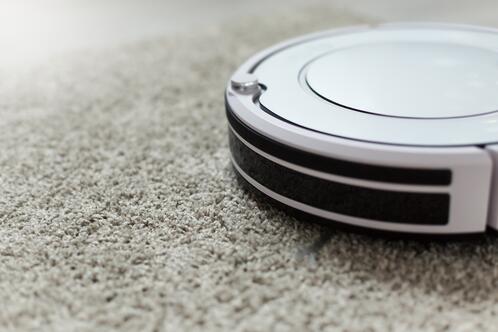In an age where robots are being used to make coffee and perform more and more automated industrial tasks, robotic vacuums are beginning to stand out as a safe and dependable product. Today’s robotic vacuums can remember the layout of a space, avoid staircases, and even be voice controlled. Some are Bluetooth and Wi-Fi enabled, allowing them to be programmed or controlled from a smart phone. Today’s blog will explore how coming advancements in robot cleaning technology will begin to create cleaner facilities in the future.
According to the recent article ‘Characteristics of High Performance Carpet Cleaning’ in the Journal of Cleaning, Restoration, and Inspection, vacuuming and professional cleaning has a big effect on the removal of soils, atmospheric dusts, toxic particulate matter, fibers, pollen, fungi, and other allergens and infectious agents. Carpet manufacturers recommend frequent vacuum cleaning accompanied by preventative maintenance and periodic restorative cleaning, like hot-water extraction to increase a facilities indoor air quality. Most carpet cleaning professionals know that vacuuming is the most important step in carpet cleaning, as it much easier to remove soil when it’s dry as opposed to wet. Janitorial companies also know that the cleanest facilities are those with great vacuuming and floor maintenance programs because they reduce airborne contaminants, however vacuuming is often neglected as profit margins are squeezed and BSCs are asked to do more with less.Enter the bots…
While robotic cleaning is still in its infancy there are numerous devices that have begun to perform the basic vacuuming tasks that are crucial to creating a cleaner environment and better indoor air quality. Since robots can be programmed to address designated areas at specific times, future vacuuming programs may be more reliable and consistent than that of humans; not to mention more productive and a lot less expensive. It seems that this first step toward more autonomous cleaning will be completed in the very near future, but there are still a few drawbacks that will inhibit complete autonomy. Humans have the ability to reach spaces such as corners or edges and can clean underneath complex objects that most robots will avoid. Until facilities are developed with robotic cleaning in mind, robots will be challenged by obstacles that they just can’t manage to get around. In addition, restorative level carpet cleaning may never be accomplished by a bot. The need for chemicals and extra water may prove to be too much effort for non-human labor, but if the robots are successful at interim maintenance that could help delay they need for the deeper cleaning after all. Another consideration is that humans will remain necessary to maintain the robots as some of them lack the ability to connect themselves to chargers or empty their waste into bins. As technology progresses these issues will be resolved.
Overall, the robotic vacuuming industry has made a lot of progress in the last few years. These products provide great supplemental cleaning and each new model is more user-friendly than the last. However, this technology does not yet fully compare to the ability of humans which is why traditional cleaning is still necessary. We look forward to seeing more progress within this industry and know that completely autonomous cleaning will come soon, resulting in fresher, cleaner buildings. Stay tuned to our blog for more news, company highlights, and more!
SHARE

